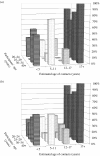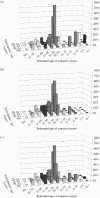Social mixing patterns for transmission models of close contact infections: exploring self-evaluation and diary-based data collection through a web-based interface
- PMID: 16707031
- PMCID: PMC2870524
- DOI: 10.1017/S0950268806006418
Social mixing patterns for transmission models of close contact infections: exploring self-evaluation and diary-based data collection through a web-based interface
Abstract
Although mixing patterns are crucial in dynamic transmission models of close contact infections, they are largely estimated by intuition. Using a convenience sample (n=73), we tested self-evaluation and prospective diary surveys with a web-based interface, in order to obtain social contact data. The number of recorded contacts was significantly (P<0.01) greater on workdays (18.1) vs. weekend days (12.3) for conversations, and vice versa for touching (5.4 and 7.2 respectively). Mixing was highly assortative with age for both (adults contacting other adults vs. 0- to 5-year-olds, odds ratio 8.9-10.8). Respondents shared a closed environment significantly more often with >20 other adults than with >20 children. The difference in number of contacts per day was non-significant between self-evaluation and diary (P=0.619 for conversations, P=0.125 for touching). We conclude that self-evaluation could yield similar results to diary surveys for general or very recent mixing information. More detailed data could be collected by diary, at little effort to respondents.
Figures


References
-
- Anderson RM, May RM. Infectious Diseases of Humans: dynamics and control. Oxford: Oxford University Press; 1991.
-
- Bailey NJT. The Mathematical Theory of Infectious Diseases. New York: Macmillan; 1975.
-
- Shkedy Z. Flexible statistical modelling: application to infectious diseases and astronomical data. Ph.D. thesisHasselt: Limburgs Universitair Centrum; 2003
-
- Klovdahl AS et al. Social networks and infectious disease: the Colorado Springs Study. Social Science and Medicine. 1994;38:79–88. - PubMed
Publication types
MeSH terms
LinkOut - more resources
Full Text Sources
Medical

